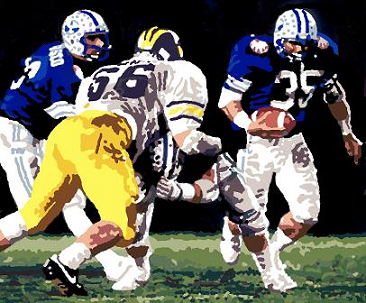2) Washington 11-1
3) Florida 9-1-1
4) Nebraska 10-2
5) Boston College 10-2
6) Oklahoma 9-2-1
7) Oklahoma State 10-2
8) Southern Methodist 10-2
9) UCLA 9-3
10) Southern Cal 9-3
11) South Carolina 10-2
12) Maryland 9-3
13) Ohio State 9-3
14) Auburn 9-4
15) Louisiana State 8-3-1
16) Iowa 8-4-1
17) Florida State 7-3-2
18) Miami-Florida 8-5
19) Kentucky 9-3
20) Virginia 8-2-2
Over the last 20 years, people have been talking about parity in college football as though it's a new thing. But parity arrived when the 1980s did. 1984 saw the 5th straight first-time "national champion": Georgia in '80, Clemson in '81, Penn State in '82, Miami-Florida in '83, and now Brigham Young in '84, the only "Little Big Team" to ever finish #1 in the AP poll.
But parity wasn't just a phenomenon at the top of the poll. It was happening top-to-bottom, and that made the 1980s a difficult decade in which to rate teams. 1984 was particularly difficult, as "upsets" were the norm every week. Anarchy reigned.
It was a lot like 2007, the "Year of the Upset," except that in 2007 unbeaten Hawaii didn't sneak off with the "national championship" without playing a ranked opponent. Say what you want about the BCS, but poor as it was, at least it protected us from that kind of crap.
The 1984 AP poll's top 20 took a huge 33.5 losses (a tie being half a loss) to lower-ranked teams, while the top 20 of the 2007 AP poll took 34 such losses. Pretty darn similar, eh? Of course, those numbers are lowered by fixing the polls, but they remain similar: 1984's fixed top 20 took 29 losses to lower-ranked teams, while 2007's fixed top 20 took 28. Looks like football writers haven't gotten any smarter over the last 30 years. On the other hand, they were smart enough to not rank Hawaii number one going into the bowls in 2007.

In the lamest and least-watched "national championship" bowl game of all time, 13-0 Brigham Young rallied to beat 6-6 Michigan 24-17. Gotta love the "pageantry" of college football's bowl system.
